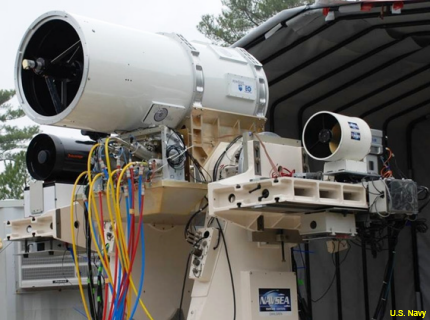Navy is on to the next phase of laser weapons
ONR awards Northrop a potentially $91 million contract to develop a more powerful directed-energy system.

LaWS, deployed aboard the USS Ponce, is the U.S. military’s first laser weapon.
Having already put its first laser weapon out to sea, the Navy is looking to go bigger, building on recent technological improvements to build a more powerful and accurate solid state system.
The Office of Naval Research has awarded Northrup Grumman Space and Mission Systems a $53 million contract—which could grow to $91 million if all options are exercised—for its Solid State High Power Laser Weapon System Demonstrator (LWSD) program. The one-year deal calls for a rapid development process intended to field a new weapon by October 2016.
The Navy, which has for decades sought a practical laser weapon, hit a milestone in the summer of 2014 with the deployment of the Laser Weapon System, or LaWS, aboard the USS Ponce in the Persian Gulf. The 30-kilowatt system is capable of taking out small boats or drones, but the Navy has said it is aiming eventually to get laser systems up to 100 or 150 kilowatts.
In its contract announcement, ONR said it is banking on improvements in laser power, beam quality, beam director architecture and other factors in building a new system.
The Navy’s research into laser weapons dates to the 1980s, when it tested megawatt-capable chemical lasers that, while powerful, prove to be messy and potentially dangerous. So research shifted to solid state systems, which are cleaner and safer, but to date less powerful because of the demands of power and cooling requirements.
The appeal of lasers, which all of the military services are looking to develop, is pretty obvious. For one thing, they’re cheaper to operate—firing a laser costs less than a dollar per shot, whereas an interceptor missile fired from a ship can cost about $1 million each. Ships also would save on space, since munitions would not have to be stored. And, of course, as long as a ship has power, it wouldn’t run out of ammo.
LaWS is operated by a controller like those in video games and is guided by the Phalanx system that is used to defend against anti-ship missiles. The Navy is using feedback on the system’s accuracy, lethality and other aspects to inform the development of other laser weapons. The service is planning to be able to install lasers on all its combat ships by the early 2020s.




